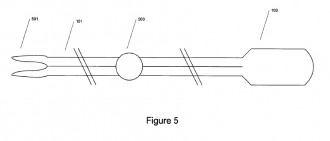
December 14, 2017
No Need to be your Own Lexicographer
The word of the day for December 14 from Wordsmith.org is ensiform, meaning sword-shaped, which is a potentially useful work for patent prosecutors, and in fact has been useful to at least a few:
U.S. Patent No. 9,061,129:
The suitable thickness or wall thickness of the septum 7a is in Some exemplary embodiments greater than twice the length of the oval shaped cannula lumen, which comes about through ensiform or Sword-shaped bevelling, or greater than twice the diameter of the circular cannula cross-section.
Col. 15: Ins. 21-25. U.S. Patent No. 5,489,406:
On the other hand, the polymeric material which forms the substance of a lacey structure can be described as multiply connected strands of polymer, with each connection point having only slightly larger dimensions that the cross-section of the strands. The strands have a length substantially larger than the largest cross-sectional dimension, and the shape of the cross-section of the strands varies from strand to strand as well as along the strand. The shape of the cross-section of the strands can be described as round or ensiform, circular or oval. The strands may have grooves or furrows, or even appear to be like a multiplicity of coalsaced filaments.
Col. 3, lns. 36-47. Lastly, U.S. Patent No. 5,460,842:
In regard to the piercing means 5, be they needles or blades, they can be made of any sufficiently rigid metal having good thermal conductivity. A preferred metal is Permanickel alloy. The surface of the piercing means should be as rough as possible, consistent with the need for the dies 9 and 15 to remove fat adhered to the piercing means. The overall configuration of the piercing means may be acicular, saggitate, lanciform, hastate, ensate, ensiform, spindle-shaped, star-shaped, or any suitable configuration for piercing a raw meat workpiece. The holes 10 and 16 in dies 9 and 15 must, of course, be complementary to the configuration of the piercing means 5.
Col. 8, lns. 7-18 is a virtual thesaurus for words describing stabby things. The English language is so rich in descriptive words that patent drafters don’t always have to make up their own.


































